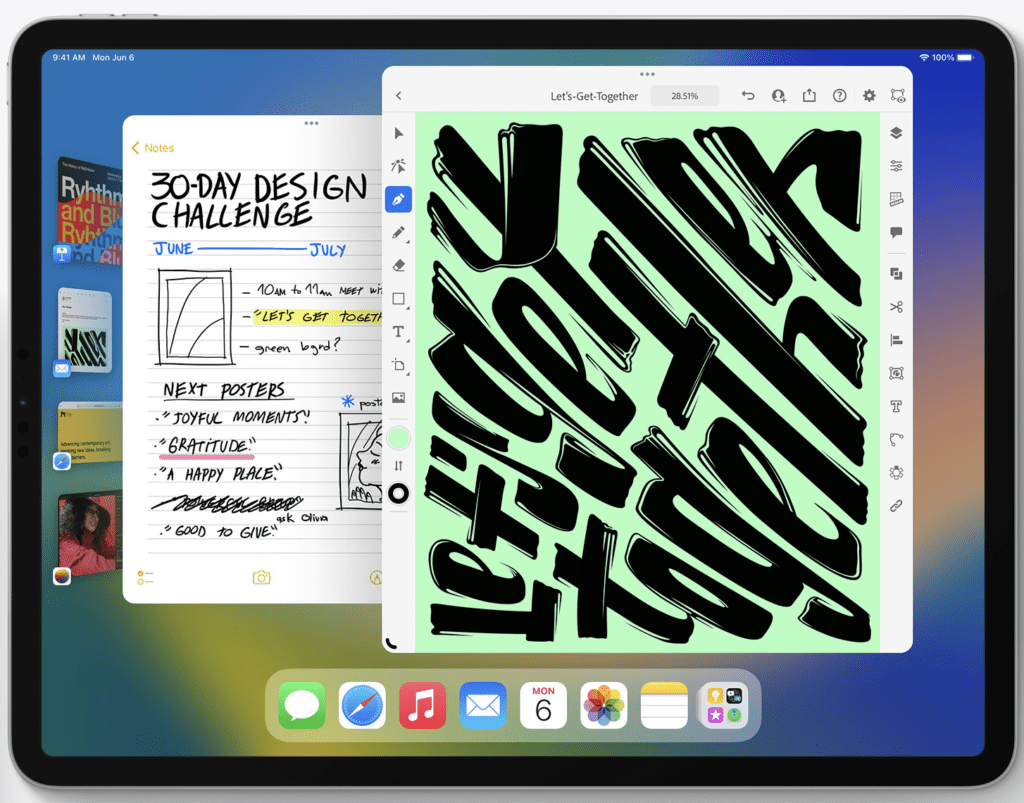Last week at Apple’s Developer conference, the company closed the keynote out with iPadOS 16. In the past, the iPad comes early in the keynote, but this time, I noticed that Apple went through every other system and saved it for the end.
This year, Apple brought about every feature they introduced to the other operating systems to the iPad, (except for the new iOS 16 lock screen, although that might be coming later). Of all the new features and apps coming, I think there were two announcements that could take the iPad to the next level: Stage Manager and Desktop Class Apps.
Stage Manager on iPadOS 16

Not everyone felt the excitement I felt about iPadOS 16 being last, but it seems that everyone is talking about Stage Manager.
Stage Manager is Apple’s newest addition to multitasking on the iPad and Mac. Unlike the already established multitasking of split-screen and slide-over, you have to invoke Stage Manager from Control Center. Once there, you can bring in apps you want to multitask with.
Users can also plug into a monitor and truly use it as an extended display and not just a mirror. Using a monitor also allows 4 more apps to be used there, so a total of 8 apps can be opened at one time on an iPad.
More than that, on the iPadOS, you finally get floating windows. Each app now lets you resize and move the window around on the screen to suit your working method. Whatever app you are currently in will be displayed in front and the other apps will float behind. This seems to be what every angry iPad user has been asking for years now. Personally, this isn’t generally how I work. I don’t usually have a ton of apps opened and floating around. I think I’m one of the strange Mac and iPad users that actually like full-screen mode. It helps me focus on what I’m working on.
But Stage Manager is not without its issues. On the iPad, Stage Manager will only work on an iPad that has an M1 chip. Apple states this is because of a new ability that is exclusive to the M1 chip that deals with memory and graphic ability. So to use the new feature, most users will need to upgrade to a newer device.
Stage Manager will satisfy many iPad users, I think (although I haven’t used it yet). It brings floating windows, monitor support, and allows multitasking with up to eight apps.
But I don’t think this is what will take the iPad to the next level.
Desktop-Class Apps
Stage Manager is all well and good, but I think another announcement Apple made that got swept under the rug a little is that it is pushing Desktop-Class Apps on the iPad. Apple mentioned during the keynote that it had scoured the system to improve its apps to bring them to desktop-class levels. They even gave a few examples, but they brushed past what and why they were doing this.

Apple is doing what I’ve been asking for a while now, and really going back into their apps and bringing feature parity to their iPad apps! I think when the iPad started, since it was just a giant iPhone, most developers took their iPhone apps and blew them up for the screen and brought over some Mac features. But Apple is now giving developers more tools to make their iPad apps more Mac like.
They seem to know that users are using their iPads for more laptop-like experiences these days and they want apps that can do it all! I know that I do. I would love if I could take my iPad with me every where and get everything I need done, but I can’t. This is a step in the right direction.
But I think Apple didn’t spend too much time on this because it is something that is hard to really show. Do you show that you have brought over the previously exclusive Mac feature in Numbers? That’s not exciting like a new multitasking paradigm is. But I think this is more important than Stage Manager.
Six Colors has a great article about what was said about desktop-like apps on iPad during the developer sessions at the event last week. Jason Snell even makes a great point that by doing the work on the iPadOS app, those apps will be even better if the developer tries to port them it to the Mac using Apple’s Catalyst developer tools.
So What?
I’m still using my iPad Pro from 2018, so I haven’t been able to test out Stage Manager just yet because it doesn’t have an M1 chip. The battery on my iPad is pathetic these days too, so I’m hoping to maybe upgrade when the next round of iPad Pros gets released, but I’m excited for the future of the iPad. Will I switch back over to the iPad Pro as my main on-the-go device? I doubt it will be anytime this year, but if the developers can utilize these tools that Apple has given them, I will happily move back to an iPad life.
But only step one has happened so far. Apple has given the tools to make this work, the developers have to actually take advantage of it. There lies the question. Will it be profitable enough for them to spend the time to do this? Of course, I will be happy to try out new software if the old ones are lagging behind.
But with these two tools coming to iPadOS 16, I think there is a chance the app life I want will come.
Discover more from JSwordSmith
Subscribe to get the latest posts sent to your email.